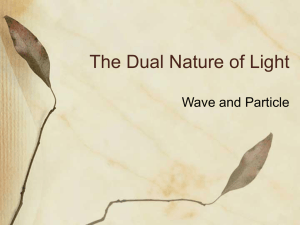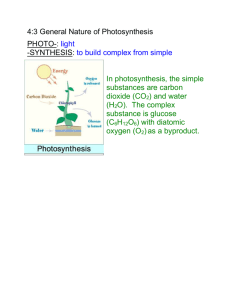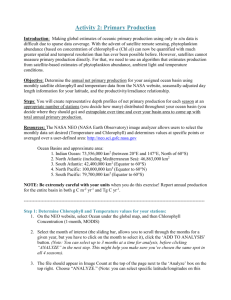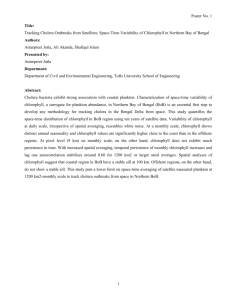Latest development in HPLC analysis of pigments
advertisement
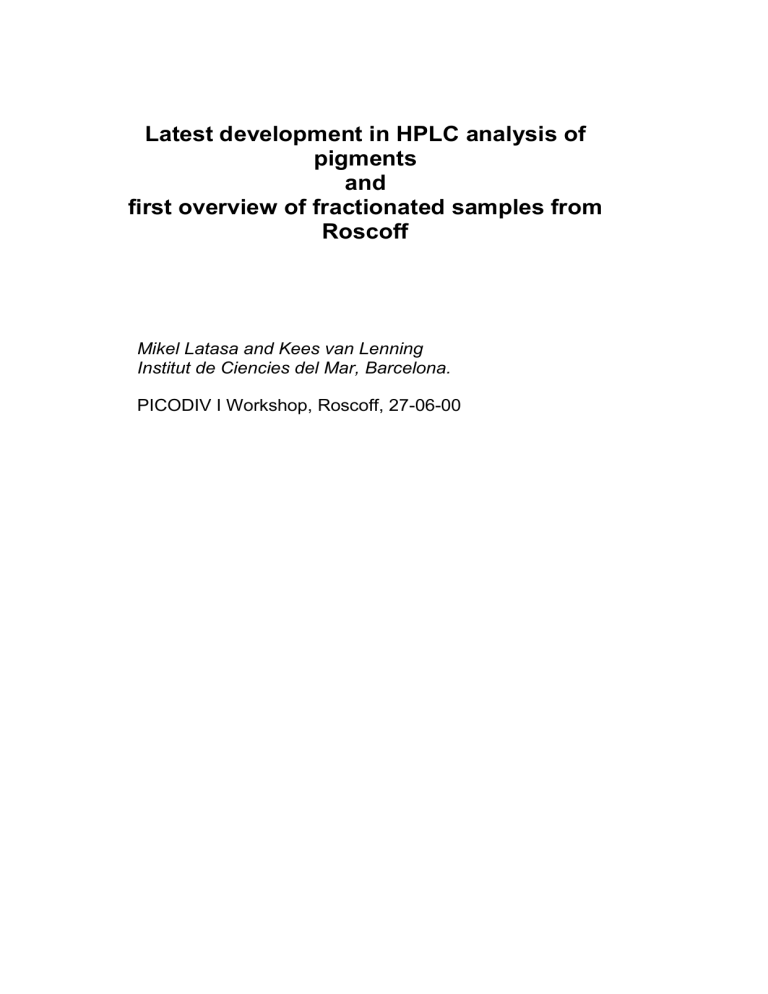
Latest development in HPLC analysis of pigments and first overview of fractionated samples from Roscoff Mikel Latasa and Kees van Lenning Institut de Ciencies del Mar, Barcelona. PICODIV I Workshop, Roscoff, 27-06-00 How can pigments be used in the framework of PICODIV? 1.- To classify isolated strains of phytoplankton because of their chemotaxonomical capabilities. 2.- To estimate natural biodiversity. Pigments should help us to estimate the contribution of the different algal classes to total phytoplankton stock. CHEMOTAXONOMICAL MARKERS Algal classes Major Pigments Prochlorophyceae Divinyl chlorophyll a, monovinyl chlorophyll b, divinyl chlorophyll b, zeaxanthin, MgDVP, alpha-carotene SynechococcusMonovinyl chlorophyll a, zeaxanthin, beta-carotene. type Phycobiliproteins. Chlorophyceae Monovinyl chlorophyll a, monovinyl chlorophyll b, lutein (zeaxanthin), neoxanthin, violaxanthin, antheraxanthin, alpha- and beta-carotene. Prasinophyceae Monovinyl chlorophyll a, monovinyl chlorophyll b, prasinoxanthin, zeaxanthin, neoxanthin, violaxanthin, MgDVP, alpha- and beta-carotene Dinophyceae Monovinyl chlorophyll a, chlorophyll c2, peridinin, diadinoxanthin, diatoxanthin, beta-carotene Prymnesiophyceae Monovinyl chlorophyll a, chlorophyll c2, chlorophyll c3, 19'hex-fucoxanthin (19'but-fucoxanthin, fucoxanthin), diadinoxanthin, diatoxanthin, alpha and beta-carotene Pelagophyceae Monovinyl chlorophyll a, chlorophyll c2, chlorophyll c3, 19'but-fucoxanthin (19'hex-fucoxanthin, fucoxanthin), diadinoxanthin, beta-carotene Bacillarophyceae Monovinyl chlorophyll a, chlorophyll c2, chlorophyll c1, fucoxanthin, diadinoxanthin, diatoxanthin, betacarotene Chrysophyceae Monovinyl chlorophyll a, chlorophyll c2, chlorophyll c1, chlorophyll c3, fucoxanthin, violaxanthin, betacarotene Cryptophyceae Monovinyl chlorophyll a, chlorophyll c2, alloxanthin, diadinoxanthin, alpha and beta-carotene. Phycobiliproteins. Other classes: Other pigments: Bolidophyceae, Eustigmatophyceae, Micromonadophyceae, Euglenophyceae, Raphidophyceae... Vaucheriaxanthin, loroxanthin, heteroxanthin, siphonaxanthin, siphonein, uriolide, gyroxanthin... + "new discoveries" The new techniques are offering new results: new pigments New methods Mono- and divinyl chlorophyll c3 4-keto-19'hex-fucoxanthin Monogalactosyl diglycerol chl c2 Other non-polar chl c Application in CODENET "Old" methods Coeluted as chlorophyll c3 Coeluted with 19'hex-fuco Non-polar chlorophyll c Unidentified 400 A 500 10 456 nonpolar Chl c Wavelength (nm) 600 700 400 Absorbance Absorbance Absorbance 0 2 * * * * * 20 A 446 472 Wavelength (nm) 500 600 30 19'-HFx 700 nonpolar Chl c Carotenes Chl a allomer Chl a 19'-Hexanoyloxyfucoxanthin Diadinoxanthin 4-Keto-19'-hexanoyloxyfucoxanthin Fucoxanthin Chl c DV-Chl c3 Absorbance 440 nm (mAU) Chlide a * 40 400 A 500 50 448 472 4-keto-19'-HFx 586 632 Wavelength (nm) 600 700 The most common exceptions: 1.- Some strains of Phaeocystis (Prymnesiophyceae) present pigment characteristics of the diatoms (Vaulot et al. 1994) 2.- The dinoflagellates and their endosymbionts. a) Gymnodinium galatheanum, Gyrodinium aureolum, and Gymnodinium breve have plastids possessing 19'hexfucoxanthin instead of peridinin (Liaaen-Jensen 1985, Tengs et al. 2000) b) Peridinium balticum has fucoxanthin and an unknown pigment (Whiters et al. 1977) c) Lepidodinium viride has chlorophyll b (Watanabe et al. 1990) The less common exceptions: 3.- Prasinophyceae with pigment composition of Chlorophyceae 4.- Prasinophyceae and Chlorophyceae with "abnormal" pigmentation (siphonaxanthin, loroxanthin...) Questions: * are these exceptions some wrong classifications by pigments or clues to revisit former classifications? * how many exceptions among picophytoplankton species? Conclusion: We need to isolate and screen picophytoplankton species for pigments. MONITORING BIODIVERSITY From measuring pigment concentrations to estimate phytoplankton diversity. Individual pigment markers: sufficient and necessary Divinyl chlorophyll a (Prochlorophyceae) Alloxanthin (Cryptophyceae) Peridinin (Dinophyceae) sufficient but not necessary Prasinoxanthin (Prasinophyceae) necessary but not sufficient Fucoxanthin (Bacillariophyceae) 19 But-fucoxanthin (Pelagophyceae) [19 Hex-fucoxanthin (Prymnesiophyceae)] Zeaxanthin (Cyanophyceae) Lutein (Chlorophyceae) To estimate biodiversity we must know the contribution of each group to the phytoplankton standing stock. Until now, the best approaches can estimate the contribution of each group to the chlorophyll standing stock ----> pigment diversity Approaches: 1) Considering one pigment marker per group. Multiple lineal regression (Gieskes and Kraay 1988). 2) Taking into account the contribution of pigments shared by different groups. a) Mathematical algorithms (Everitt et al 1990, Letelier et al 1993). b) CHEMTAX (Mackey et al 1996) Possible failures of this approach: a) the ascription pigment to taxa is based on few isolates in some of the groups. b) uncertainties in the "seed" pigment ratios (CHEMTAX's error limit is ±35%) because of: - changes due to physiological state - changes due to intraclass variation CONCLUSIONS: Pigment analysis is a very useful tool to classify isolated phytoplankton strains. New HPLC techniques are revealing new pigments which can improve the classification of phytoplankton strains. The agreement between the pigment composition of picophytoplankton and their correspondent algal groups is largely unknown. The step from pigment concentrations to quantification of the contribution of the different groups to total algal stock is not immediate. A definite push pursuing this goal has been the development of CHEMTAX. There is an urgent need for isolating and culturing field species of (phyto)plankton and, above all, picoplankton. 0 10 // 2 Chl c * * 20 Zeaxanthin Lutein Alloxanthin * * 30 * 40 Carotenes Chl a epimer Chl a allomer MV + DV-Chl b * Chl a Fucoxanthin Neoxanthin Prasinoxanthin Violaxanthin 19'-Hexanoyloxyfucoxanthin Diadinoxanthin 19'-Butanoyloxyfucoxanthin Peridinin 1 Chl c DV-Chl c3 Chlide a MgDVP Absorbance 440 nm (mAU) FIRST RESULTS of pigment analysis from Roscoff 50 R00301 GF/F R00329 < 3 um R00301 R00329 > 3 um R00301 Chl b Zeax Allox Per19but 19hex Chl b Chl b Per Per 19but 19but 19hex Fuco Fuco Zeax Zeax Allox Allox 19hex 19hex Fuco Fuco Fuco Otros Otros Per 19but Per Allox 19but Zeax 19hex Chl b Allox Zeax Chl b R00313 GF/F R00313 < 3 um R00313 > 3 um Per Per 19but 19but Fuco Per Fuco Chl b Fuco Chl b Zeax Otros 19hex 19hex 19hex Allox Allox 19but Allox Zeax Zeax Chl b R00329 GF/F R00329 < 3 um Per Per Chl b R00329 > 3 um 19but 19but Chl b 19hex Zeax Allox Fuco Zeax Otros Otros Per Fuco 19hex Fuco Fuco Allox 19hex 19but Per Allox 19but Zeax 19hex Chl Alloxb Zeax Chl b R00412 GF/F R00412 < 3 um Per Per Chl b R00412 > 3 um Per 19but 19but Chl b Fuco Chl b Otros Zeax Fuco Fuco Allox 19hex 19hex Allox 19hex Zeax 19but Zeax Allox R00427 GF/F R00427 < 3 um R00427 > 3 um Per Per 19but 19but Per 19hex Fuco 19but Chl b Fuco Chl b Zeax Allox Allox Zeax 19hex Allox Zeax 19hex Fuco Otros Chl b Total chl a, from GF/F filters and from the sum of the fractions 700 600 -19% GF/F Sum 42% -27% ng / L 500 400 300 34% 7% 200 100 0 R00301 R00313 R00329 R00412 R00427 Sample Percentage of the total chl a in the < 3 um fraction 100 80 %Chla < 3 um % 60 40 20 0 R00301 R00313 R00329 Sample R00412 R00427 Shannon's index Pigment diversity in the different size fractions 3.0 GF/F < 3 um > 3 um 2.5 2.0 1.5 1.0 0.5 0.0 R00301 R00313 R00329 Sample R00412 R00427 No Prochlorococcus pigment signatures in any of the samples. The dominant groups in terms of pigments are always diatoms and green algae. The green algae seem to be Prasinophytes and not Chlorophytes. Other main players are Cryptophytes, Haptophytes and Dinoflagellates. Cyanobacteria, Crysophytes and Pelagophytes are always minor components (if at all). Diatoms dominate completely (more than 75% in pigment biomass) the > 3 um fraction. The < 3 um fraction is dominated mostly by green algae and diatoms. CONCLUSIONS The agreement, in terms of chlorophyll, between the sum of the < 3 um and > 3 um fractions and the total fraction (GF/F) should be improved. The picophytoplankton made between 40% and 80% of the total chlorophyll a in this coastal site (median is 50%). There were not important shifts in pigment composition in spite of a 3-fold change in chlorophyll concentration Diatoms were an important component of the < 3 um fraction The pigment diversity was much higher in the < 3 um fraction These are preliminary data and all these conclusions are based on raw pigments. The application of CHEMTAX will most likely modify the estimated contribution of each group.


